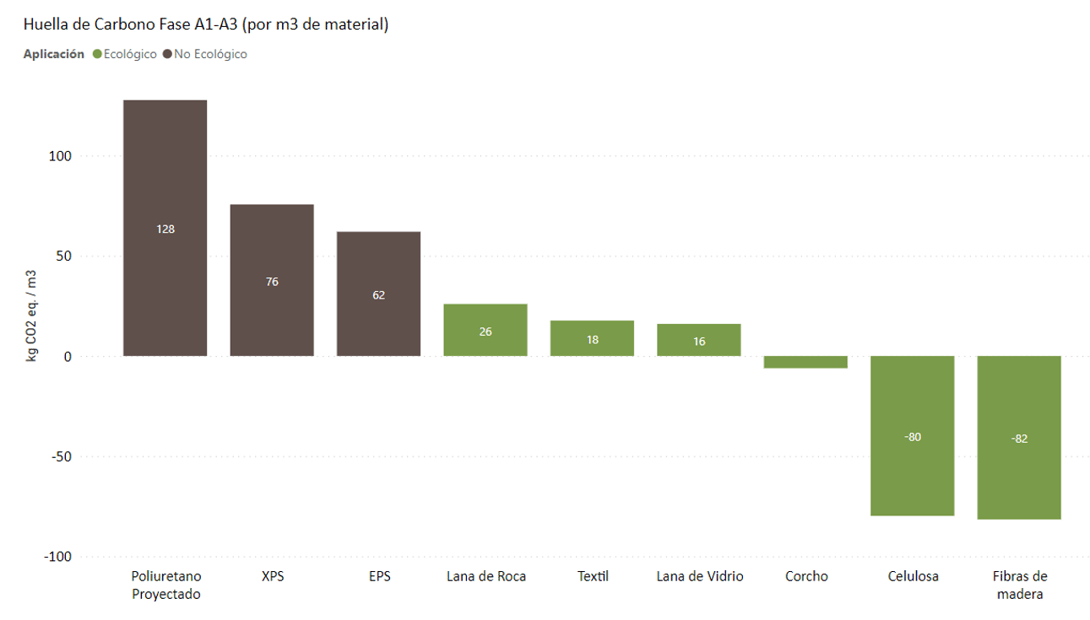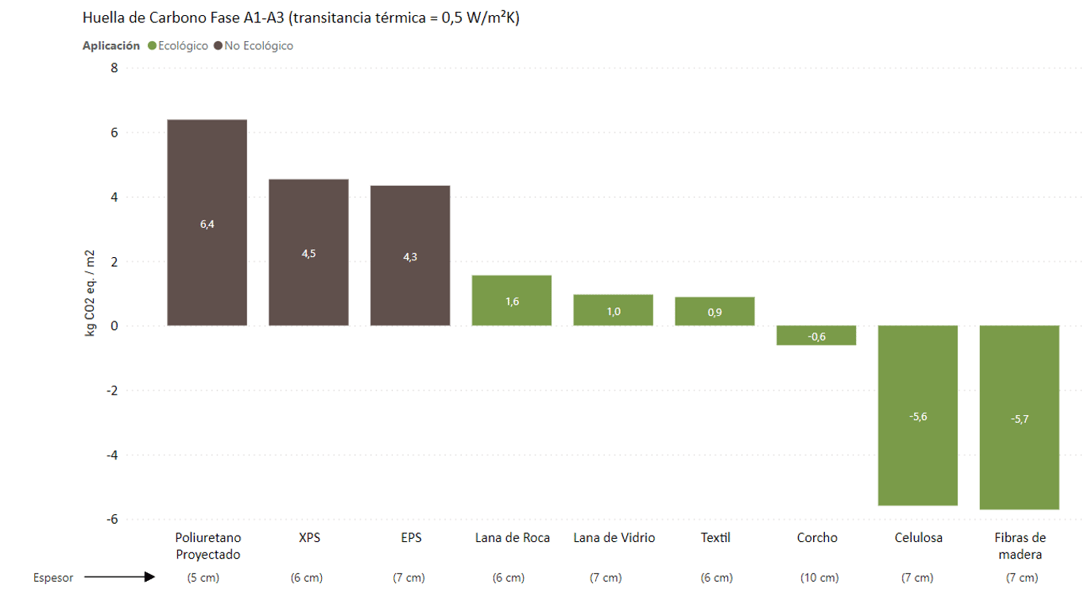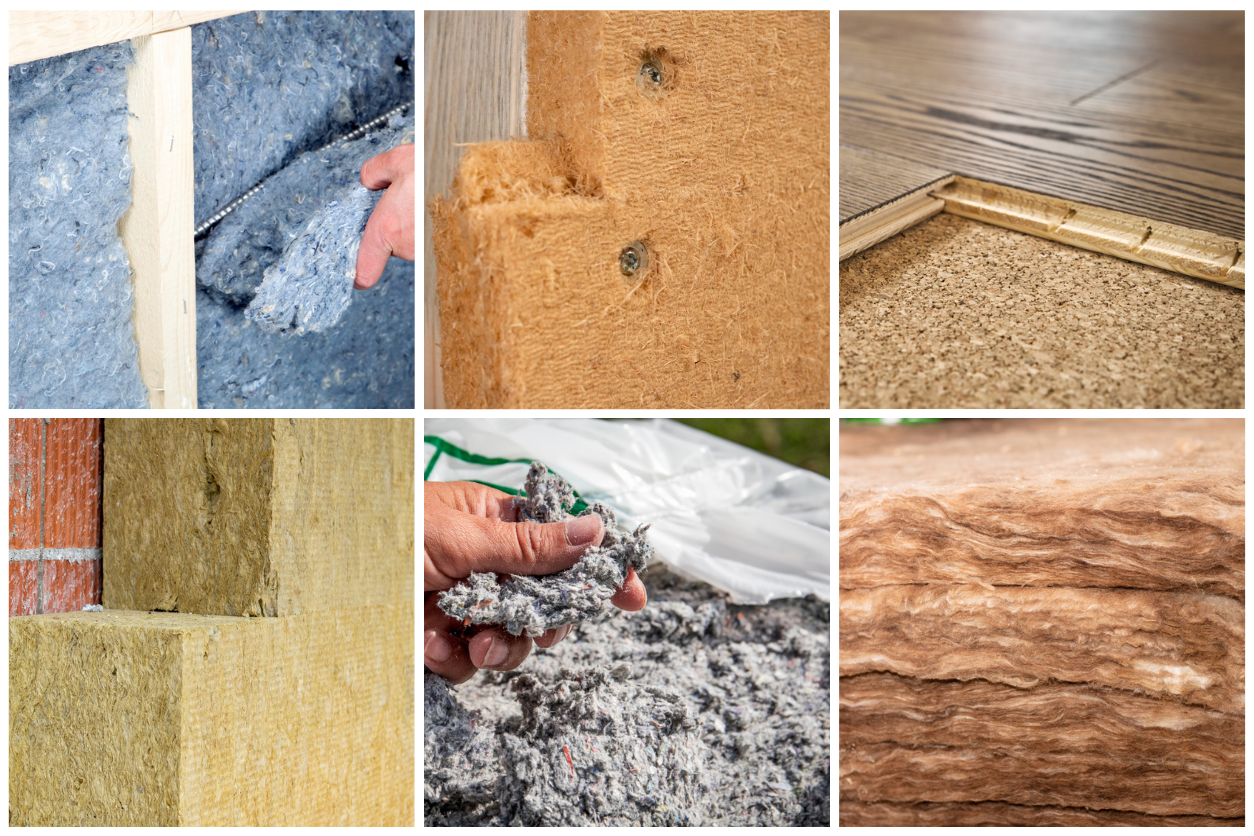In the colder months of the year, it is common to wonder if our homes or buildings are properly insulated and efficient in minimizing heat loss. It is therefore the right time to talk about sustainable alternatives to properly insulate buildings and the different types of eco insulation that are available.
In this article, we go one step further and look not only at the most common types of eco insulation, but compare their embodied carbon emissions to draw conclusions about which is better for the environment.
What is eco insulation?
The eco insulation is characterised by the fact that it has not been transformed prior to its use in the building. That is to say, the natural properties of these types of materials remain intact when used in the construction or rehabilitation phase of a building.
The use of ecological insulation in construction and renovation projects, in conjunction with the use of other sustainable and efficient materials, contributes to the overall reduction of the carbon footprint of buildings, as calculated through Life Cycle Assessment.
Key criteria for this type of insulation also include the ability to be recycled or biodegradable at the end of its useful life, as well as being manufactured with processes that minimise energy use and carbon emissions.
In the market, there is a wide variety of ecological insulations available, so we consider it interesting to look in detail at the most commonly used types and compare the embodied carbon footprint of each one to see which one has a lower environmental impact.
Types of common eco insulation
Let's have a look at some of the basic characteristics of the main types of eco insulators on the market and most commonly used:
| Type of insulation (eco insulation) | Main Features |
| Wood fibres | It is obtained from the process of crushing untreated natural wood. It has excellent thermal and acoustic insulation properties, and is also lightweight and easy to handle. |
| Cellulose | Manufactured from recycled paper or wood pulp, cellulose stands out for its efficient thermal insulation, being biodegradable. |
| Cork | Extracted in a sustainable manner from the bark of the cork oak, cork is a natural insulator with outstanding thermal and acoustic properties. |
| Glass Wool | Coming from recycled glass and silica sands, it offers high thermal and acoustic insulating power, is fire-resistant, and does not promote bacterial growth. |
| Rock Wool | Manufactured from volcanic rocks, it is recognized for its good thermal and acoustic insulation. Its durability, resistance to high temperatures, and resistance to deformation make it a robust and sustainable choice for construction. |
| Textile | Composed of recycled textile fibres or sustainable materials. |
On the other hand, let us also look at some of the insulation materials that are not environmentally friendly, but are commonly used in the construction and rehabilitation of buildings. It is also important to know them since in the next section we will compare them with the ecological ones:
| Type of insulation (non-ecological) | Main Features |
| Sprayed polyurethane | This insulator, applied in liquid form and expanding as it dries, offers efficient thermal and acoustic insulation. It may contain sustainable components and act as a sealant for cracks. |
| XPS (Extruded Polystyrene) | It is a rigid foam resulting from the extrusion of polystyrene which is lightweight, with great mechanical resistance and water tolerance. |
| Cork | Material manufactured from pre-expanded, lightweight, water-tolerant, expandable polystyrene bead moulding. It can be recycled. |
Comparison of emissions of the main insulations
Establishing a comparison between the main types of insulation on the market allows for decisions to be made about which materials are best to use in each case. In our case, we separated the comparison into two parts, each giving us different valuable information:
- First, we compared the carbon footprint of eco and non-eco insulation perm3 of material.
- Secondly, we compared the carbon footprint of eco and non-eco insulation by matching their thermal transmittance at 0.5W/m2K.
It is worth mentioning that in both cases we focus on the phases A1-A3 of the life cycle of the materials, corresponding to their manufacture.
1. Comparison of insulation perm3 of material
Let's look at the carbon footprint of the main insulation materials we use for the construction and building rehabilitation:

As we can see in the graph, the environmental impact of non-eco insulating materials (marked in brown) is between 62 and 128 kg CO2 equivalent per cubic metre of material.
In contrast, the environmental impact volume of eco insulation (in green) is considerably lower in comparison, ranging from 26 to 82 kg CO2 equivalent per cubic metre of material. Therefore, we can conclude that the production of eco-friendly insulation involves fewer CO2 emissions.
The negative values in terms of kg of CO2 equivalents are due to materials such as cork, cellulose, or wood fibres being carbon sinks, meaning their natural characteristics have the ability to trap carbon dioxide.
This graph gives the impact perm3 of each insulation and indicates the emission range of the eco and non-eco insulation group.
2. Comparison of insulations equalizing the thermal transmittance
In order to compare the carbon emissions of the main types of insulation, we have equalized the thermal transmittance of these materials, as not all of them have the same thermal conductivity. Equalising the thermal transmittances (in this case at 0.5 W/m2K) will define the required thickness (indicated at the bottom of the graph) of each material according to its usual conductivity.
In the case of insulation, it is important to equalize thermal transmittances in order to compare carbon emissions during their manufacture, as their main purpose is to reduce the heating and cooling demand of buildings to improve their passive performance. In this way, we can compare the insulations in such a way that they have a similar thermal behaviour, thus eliminating the variable of operational consumption.

We see that, to achieve equal thermal transmittance, eco insulation tends to require a greater thickness of material. This is because materials treated in a non-natural way can achieve more efficient thermal characteristics with less thickness, but consequently their carbon footprint increases significantly.
If we look at the values, the eco insulation of cork, cellulose, and wood fibres is negative again, for the same reason we mentioned earlier. Sprayed polyurethane remains the material with the largest environmental footprint derived from its manufacture, followed by XPS and EPS.
We can also see that the material with the best thermal conductivity is extruded polyurethane, as only 5 cm thickness is needed to achieve a thermal transmittance of 0.5W/m2K, while the material with the worst thermal conductivity is cork, as in this case 10 cm thickness is needed. Even so, the emissions from sprayed polyurethane are more than 10 times higher than those from cork.
Conclusions
As can be seen below, the conclusions drawn from the comparison perm3 of material and the comparison by matching the thermal transmittance are very similar.
Wood fibres, cellulose and cork are in the TOP 3 with negative emissions in their manufacturing phase, while in the last three places we find non-eco insulation (EPS, XPS and sprayed polyurethane) with emissions at least three times higher than those of eco insulation.
The TOP 4 and 5 is a close contest between glass wool and textile insulation, because, although textile insulation generates fewer emissions perm3 in its production, glass wool generally has a better thermal insulation performance, thus saving 1 cm in thickness compared to textile insulation.
| Insulation | TOP 9: Comparison perm3 of material | TOP 9: Comparison by equalizing the thermal transmittance |
| Wood fibres | 1 | 1 |
| Cellulose | 2 | 2 |
| Cork | 3 | 3 |
| Textile | 4 | 5 |
| Glass Wool | 5 | 4 |
| Rock Wool | 6 | 6 |
| EPS | 7 | 7 |
| XPS | 8 | 8 |
| Sprayed polyethylene | 9 | 9 |
In short, insulation is a key material in our projects and choosing it taking into account its thermal efficiency but also its carbon footprint in its manufacture is essential to define strategies for the reduction of CO2 emissions in buildings.


